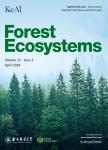Evaluating soil nutrients of Dacrydium pectinatum in China using machine learning techniques
Evaluating soil nutrients of Dacrydium pectinatum in China using machine learning techniques作者机构:State Key Laboratory of Tree Genetics and BreedingKey Laboratory of Tree Breeding and Cultivation of the State Forestry AdministrationResearch Institute of ForestryChinese Academy of ForestryBeijing100091China Research Institute of Forest Resource Information TechniquesChinese Academy of ForestryBeijing100091China Hainan Bawangling National Natural ReserveChangjiang572722HainanChina Department of Biological ScienceInstitute of Environment SciencesUniversity of Quebec at MontrealMontrealQCCanada
出 版 物:《Forest Ecosystems》 (森林生态系统(英文版))
年 卷 期:2020年第7卷第3期
页 面:378-391页
核心收录:
学科分类:09[农学] 0903[农学-农业资源与环境] 090301[农学-土壤学]
主 题:Support vector machine KNNSVM Generalized regression neural network Nutrient grade Rare and endangered tree species
摘 要:Background: The accurate estimation of soil nutrient content is particularly important in view of its impact on plant growth and forest regeneration. In order to investigate soil nutrient content and quality for the natural regeneration of Dacrydium pectinatum communities in China, designing advanced and accurate estimation methods is ***: This study uses machine learning techniques created a series of comprehensive and novel models from which to evaluate soil nutrient content. Soil nutrient evaluation methods were built by using six support vector machines and four artificial neural ***: The generalized regression neural network model was the best artificial neural network evaluation model with the smallest root mean square error(5.1), mean error(-0.85), and mean square prediction error(29). The accuracy rate of the combined k-nearest neighbors(k-NN) local support vector machines model(i.e. k-nearest neighbors-support vector machine(KNNSVM)) for soil nutrient evaluation was high, comparing to the other five partial support vector machines models investigated. The area under curve value of generalized regression neural network(0.6572) was the highest, and the cross-validation result showed that the generalized regression neural network reached 92.5%.Conclusions: Both the KNNSVM and generalized regression neural network models can be effectively used to evaluate soil nutrient content and quality grades in conjunction with appropriate model variables. Developing a new feasible evaluation method to assess soil nutrient quality for Dacrydium pectinatum, results from this study can be used as a reference for the adaptive management of rare and endangered tree species. This study, however, found some uncertainties in data acquisition and model simulations, which will be investigated in upcoming studies.



